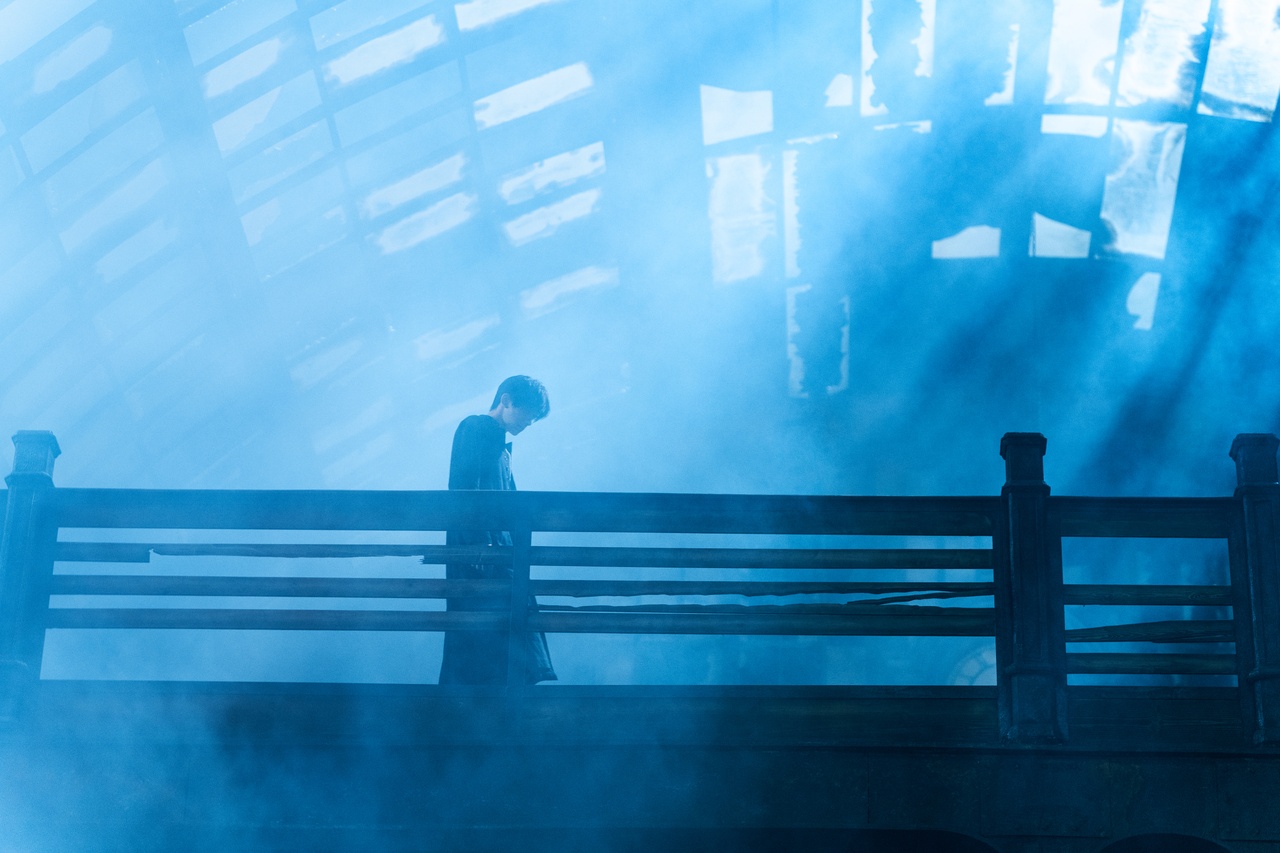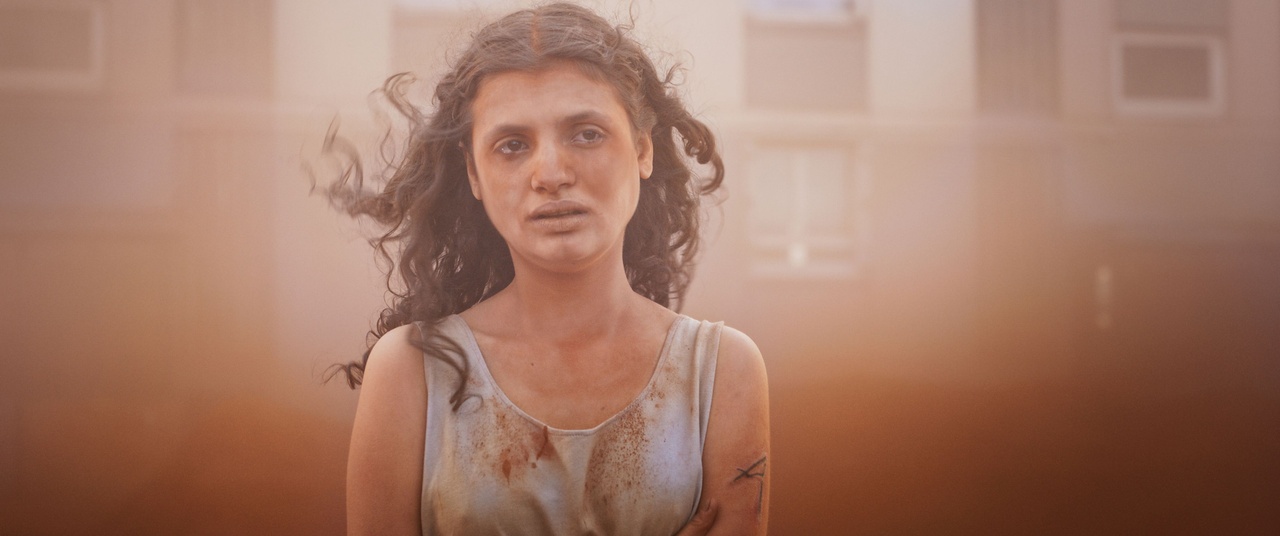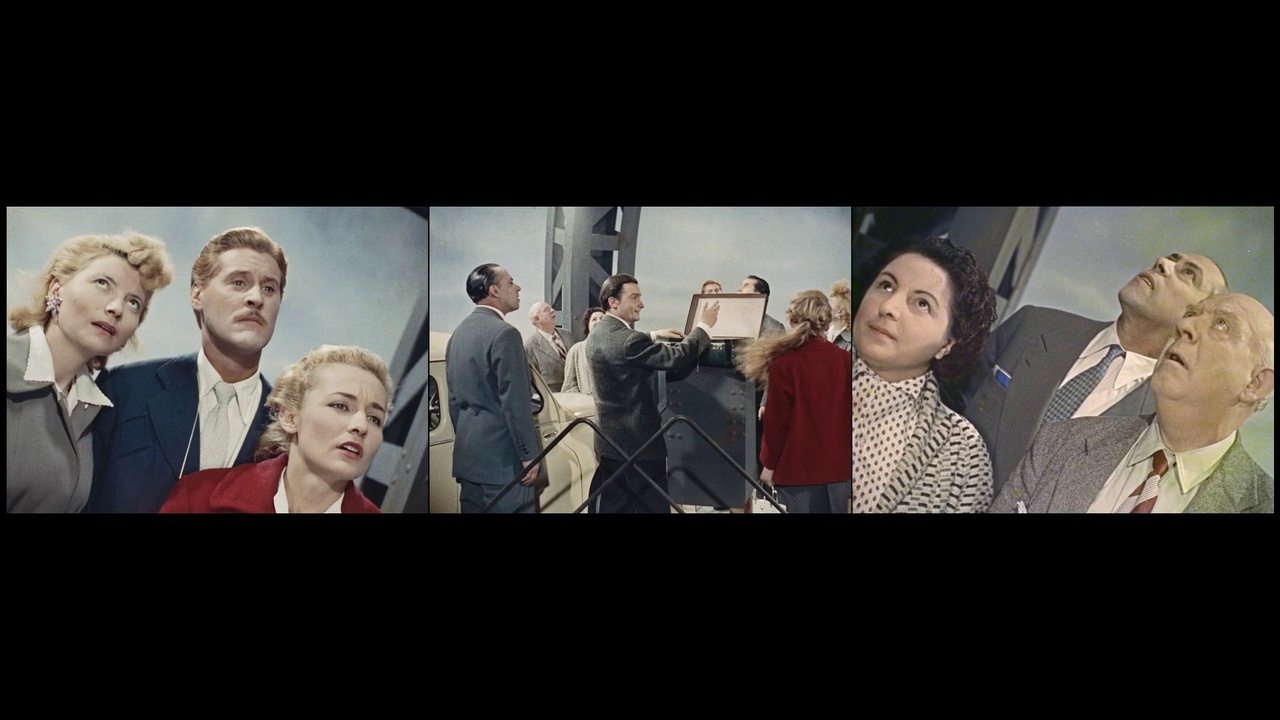SABOTEURS, DOGMATISTS, AND TIME TRAVELERS George MacBeth on the 78th Cannes Film Festival

Bi Gan, “Resurrection,” 2025
There was something amiss during my final few hours in Cannes. On the morning of the festival’s closing day, as I joined the throng of other weary lanyard-bearers soon set to depart the 78th Cannes Film Festival, the streets were filled with baffled shopkeepers filing out from the suddenly darkened interiors of Hermès, Louis Vuitton, and other luxury goods stores that stud the shorefront Promenade de la Croisette. In the blazing sun, I saw clusters of tuxedoes and ball gowns drinking lemonades rather than coffee on the café terraces. From a distance came the steady whine of sirens and security alarms. A friend seated in the Théâtre Debussy texted me to say that the 8:30 showing of Oliver Laxe’s Sirât had been interrupted, and that the assembled critics were all huddled in the darkness listening to Ravel. The bartender at one of the resort’s uniformly mediocre and overpriced cafés explained to the crowd that we would all need exact change for our croissants, because they couldn’t open the cash desk. “The power has been cut! Didn’t you hear?”
This disruption was later claimed as an action by an anarchist collective, who “sabotaged the main substation supplying the Cannes area and sawed through the 225 kV line coming from Nice.” [1] In their communique “Et … coupez!” the activists explained their rationale (and their true targets) in the well-honed idiolect of twentieth-century Gallic agitprop:
While external generators supplying the cinemas of the main complex soon enough ensured that the show would, indeed, go on, this act of sabotage succeeded in bringing the war (and the economy that sustains it) home to a festival that had otherwise seemed to only dimly glimpse the world beyond the screen.
On the opening night of Cannes 78, upon receiving an honorary Palme d’Or, Robert De Niro declared to rapturous applause that “Art looks for truth. Art embraces diversity. […] And that’s why we are a threat to autocrats and fascists!” Founded in 1939 by Philippe Erlanger – who advocated for a politically independent festival following the intervention of Mussolini and Hitler in 1938 to overrule the Jury at that year’s Venice Mostra (ancestor of today’s Venice Film Festival) – the Cannes festival’s origins were incontestably anti-fascist. As it has grown inexorably to become the powerhouse broker of cultural capital it is today – “a metonym for a bonanza of industry trading and red carpet photocalls” as Caitlín Doherty adroitly described it [3] – Cannes has weathered many protests and political storms along the way. The most canonical of these was of course the Nouvelle Vague’s decisive intervention to halt the 1968 edition in light of the student protests then rocking the country (when Jean-Luc Godard, Jacques Rivette, François Truffaut, and other critic-filmmakers led the charge). As with the saboteurs cutting the electricity lines today, the stipulation of filmmaker-activists like Godard was that the “obscene ceremony” of such an occasion placed itself profoundly out of step with the demands of mediating the given sociopolitical conjuncture. As he pronounced in ’68: “Not one film portrays the problems experienced by the workers or students of today, not one. We are behind the times.” [4]
Though there was a great deal of carping in the run-up to this year’s festival about the stuffy sartorial code on red carpet attire for premieres (no “nudity,” no big gowns), perhaps no episode better signaled Cannes asynchronously lagging behind the times than the announcement by a group of filmmakers from Copenhagen of their “Dogma 25” declaration. [5] Their widely publicized “vow of chastity” was of course an act of homage to the famous “Dogme 95” manifesto written by Lars Von Trier and Thomas Vinterberg and metonymically tied to films like Von Trier’s The Idiots, Vinterberg’s Festen (both 1998), and (albeit more loosely) Harmony Korine’s Julien Donkey-Boy (1999). Where the original Dogme served as a useful corrective to certain bloated tendencies in ’90s arthouse, this second pressing seemed more cloth-eared – if not outright reactionary. Resemblant to the Stuckist movement’s opposition to the Young British Artists, the group’s demands for signatories to prohibit all makeup, produce handwritten scripts, and place the internet “off limits in all creative processes,” seemed more like an effort to foreclose the possibilities of innovation in the medium rather than open new ones up.

Julia Ducournau, “Alpha,” 2025
The selection process for the films in competition at Cannes is shrouded in pontifical secrecy, inviting a fever pitch of speculation in the lead-up to their announcement. [6] This year’s selection nevertheless saw a crop of bankable auteurs returning, with new films from Wes Anderson, Joachim Trier, Kelly Reichardt, Julia Ducournau, and the curiously ubiquitous Brothers Dardenne. Of these, Ducournau’s Alpha – following her Palme d’Or win for Titane in 2021 – was one of the most eagerly anticipated.
An allegorical family drama with greater sociopolitical aspirations than its abrasive predecessor, Alpha follows its eponymous teen, who potentially contracts a lethal disease after being forcibly tattooed at a party (a large A that suppurates on her triceps). Somewhat vague about its specific where and when – though eddying between either the presidency of François Mitterrand or Jacques Chirac – Alpha (played by Mélissa Boros) lives amidst a moment of heightened paranoia and stigmatization surrounding a mysterious epidemic, which claimed the life of her estranged uncle Amin (an extraordinary, fidgety, winking performance from Tahar Rahim). We learn via Alpha’s mother, a Mother Theresa–like figure on an inpatient ward for sufferers of the disease, how this condition turns those who have contracted it into marbled husks with lips that emit a chalky film. The art direction in these hospice sequences is Ducournau’s most visually audacious gambit, inviting comparisons to the brittle soft-hardness of Matthew Barney’s terracotta and Vaseline sculptures that were part of his “SECONDARY” exhibition series last year. Alpha’s post-Covid, post-AIDS fable works best when it toys with the suggestion that the neurosis of the protagonist’s mother regarding her daughter’s sickness (even when repeated tests appear to place her in the clear) may be an instance of Munchausen syndrome by proxy, born from her own prolonged care for the diseased. Ultimately, however, the film fails to commit to this direction, as it does so many others. As with several other French body horrors of late (such as Coralie Fargeat’s The Substance, 2024), once its allegoric premise has been sufficiently established, Ducournau’s film finds itself hemmed into a corner from which it struggles to wriggle clear, so that by its final act Alpha resorts to an increasingly shrill saturation of extreme (and often vulgar) audiovisual and narrative gimmickry to fight its way through to an incoherent resolution.
Far more rewarding was Christian Petzold’s Miroirs No. 3, shown outside of the competition as part of the Directors’ Fortnight. This was an enigmatic and equally allegorical exploration of unspeakable loss, shot on location in a Brandenburg which looks like Kansas. Here was a film which seemed totally assured of its destination from the outset – in which every dramatic component felt calculated with an artisanal precision. Petzold’s clipped, precise yet never austere filmic economy put me in mind of how Akira Kurosawa chose to praise his peer Mikio Naruse (whose wonderful if morose Floating Clouds [1955] was screened in the Cannes Classic segment in a new restoration): “The flow [of Naruse’s films] is so magnificent that the splices are invisible. This flow of short shots looks calm and ordinary at first glance then reveals itself to be like a deep river with a quiet surface disguising a fast-raging current underneath.” [7]

Christian Petzold, “Miroirs no. 3,” 2025
In Miroirs, Paula Beer plays Laura, a young conservatoire student who seeks shelter and a form of solace in the home and domestic routines of a kind stranger, Betty, after surviving a car accident in which her boyfriend dies. Betty’s immediate generosity and hospitality toward this stranger – which has more than a helping of the Brothers Grimm to it – sets in motion a reckoning with familial ghosts that intimates the “fast-raging current” underneath the “deep river with a quiet surface” of which Kurosawa spoke. Presented as the conclusion to the loose “elemental” trilogy he began with 2020’s Undine, Petzold’s latest finds him returning to the oblique and unsettling themes that defined his early collaborations with Harun Farocki – in works such as the “Ghosts” trilogy, Something to Remind Me (2001), and Wolfsburg (2003). As in these films, Miroirs portrays Germany as a country “suffering from a sort of collective amnesia,” [8] where the interpersonal dimensions of loss and the legacy of unspoken violence (in this instance the lethal car accident memory-holed in the opening sequence, an echo of the car accident in Wolfsburg) have percolated into a form of intangible dread that hangs between people.
When you watch enough films in an environment as peculiar as Cannes – running the gauntlet between venues titled after dead auteurs (Luis Buñuel, Agnès Varda) through interminably crowded, pseudo-militarized checkpoints to watch multiple, often forgettable, films a day – strange couplings start to present themselves. Scenes and images intermingle in the short intervals between screenings. One such this year was the unexpected alignment of Abel Gance (the French auteur behind Napoléon [1927], who died in 1981 aged 92) and Bi Gan, the youngest director in the competition, a self-taught wunderkind from Guizhou Province, China. Both directors offered glimpses of a cinema that seeks to utilize all the technological means and innovations currently at its disposal to remodel perception, and a welcome riposte to the backward-facing puritanism of the Dogma 25 signatories.
Gance’s work appeared this year in the Cannes Classics segment with an extraordinary screening of his final experimental film, Magirama (1956), a collaboration with the Argentine French filmmaker Nelly Kaplan. Following the recent restoration of Napoléon, as the product of 30 years of painstaking research by the CNC, Magirama is a portmanteau of four films utilizing Gance’s innovative format of “polyvision,” which combines three separate projections into a delirious non-linear viewing experience that presciently anticipates the use made of split-screen projections by many contemporary moving image artists. A remixing of films and footage from throughout his career – including sequences from La fin du monde (1931) and J’accuse! (1938) – Magirama’s decentering of the monovisual gaze undertakes what Viktor Shklovsky termed the “knight’s move” of radical art, taking a lateral formal route to arrive to us 70 years after its original creation as an ultracontemporary artifact. [9]

Abel Gance with Nelly Kaplan, “Magirama,” 1956
Bi Gan’s Resurrection, meanwhile – by far the standout picture I saw from this year’s official slate, though it almost didn’t make it, having reportedly been picture locked only two days before its premiere – was also a profoundly untimely film that confounded most efforts at capture. As the director stated in his press conference, “I have a very specific relation to time. It’s as though we move from one scene to the next, without knowing which one the scene belongs to.” As difficult to synoptically encapsulate as his previous two features, Kaili Blues (2015) and Long Day’s Journey into Night (2018), Resurrection follows the “Fantasmer” (played by the superstar model and singer Jackson Yee), a solitary dreamer in a world where people have long since ceased to dream. That’s about it, plot-wise. Across the 2-hour 40-minute runtime of Resurrection, we track this lone dreamer as he reappears throughout a century of Chinese history, structured into six semi-discrete segments, each of which assumes a different cinematic vernacular without ever lapsing into the pastiche of someone raiding a dressing-up closet.
The film begins in an early-20th-century music hall, with the attendees one by one turning around in their seats to scrutinize us, and ends in a melting wax theater filled with scintillating pinpricks of light. The opening sequence conjures up the protean world of early cinema, taking a character known as “the Big Other” (played by Shu Qi) on a lysergic chase through a dissolving landscape of Expressionist sets to discover the Fantasmer in the guise of a Nosferatu-like “movie monster,” with mesmeric stylistic flourishes reminiscent of the Brothers Quay or Guy Maddin and ironizing expository intertitles. This is then followed by a highly stylized oneiric twenties noir; a more sober and metaphysical Tarkovskyian segment in a temple of Buddhist statues that keep crumbling to dust; a melodrama featuring a clairvoyant street urchin and a con man; and a vampiric urban love story staged as a chase through the rain-sodden, neon-drenched eve of the new millennium, which summoned up the seductions of Hou Hsiao-Hsien’s “Urban Youth” trilogy. During this penultimate New Year’s Eve section, one of Bi’s distinctive one-takes, I heard a fusillade of soft gasps around me in the press screening – as the film’s unique mechanics saw a handheld POV pursuit sequence give way to an RPG-style floating hands shot, before segueing through a mobster’s heartfelt karaoke rendition to a time-lapsed screening of Louis Lumière’s L’arroseur arrosé (the earliest known film comedy, from 1895) in the street outside the karaoke bar. In part a transgenerational paean to the power of cinema in the tradition of films like Theo Angelopoulos’s Ulysses’ Gaze (1995) or Víctor Erice’s recent Close Your Eyes (2023), during its many genuinely daring and visionary stretches Resurrection had that rarest cinematic quality of all: appearing like an organic life-form undergoing a process of cellular division and mutation before our very eyes.
On my penultimate night in Cannes, while the anarchists presumably crept under cover of darkness toward the city’s electrical supply station, I watched with a group of friends from the beach as a geyser of fire shot up high into the air from one of the distant yachts clustered on the horizon line.
Somewhere between the €400,000-a-week chartered yachts, the industry ballyhoo, the performative red-carpet stunts, the “straight-to-Mubi” festival films, the saboteurs, and the Dogmatists, at Cannes there were still many films that tried to mediate the conditions of global crisis without subtending themselves to mere illustration. Sometimes this came through approaching these conditions head-on – as in the culminating installment of Sylvain George’s Nuit obscure trilogy made with (rather than “about”) young Moroccan migrants in Paris, or Lav Diaz’s postcolonial epic Magellan, which frontally depicted the necropolitical logic of the Portuguese explorer Ferdinand Magellan’s colonial expedition to the East Indies. More often, however, the hysterical contradictions of the present moment felt best brought into focus by filmmakers who assumed a parallax view, ensnaring the present between multiple sightlines – whether this was at the chamberlike, interpersonal scale of Petzold’s Brandenburg fairytale or at the gargantuan, century-long dimensions of Bi’s Resurrection. Traipsing through the blacked-out streets of Cannes on that final morning, the parting words of the final intertitle from Bi Gan’s dreamscape were stuck with me: “Farewell, even though the Earth has already collapsed.”
Julia Ducournau, Alpha (France 2025); Christian Petzold, Miroirs No. 3 (Germany 2025); Abel Gance and Nelly Kaplan, Magirama (France 1956), Bi Gan, Resurrection (China 2025).
George MacBeth is a writer based in Berlin. He is the editor of the e-flux Index.
Image credits: 1. © Dangmai Films, courtesy Festival de Cannes; 2. © Mandarin & Compagnie Kallouche Cinema Frakas Productions France 3 Cinema, courtesy Festival de Cannes; 3. © Schramm Film / ZDF / Arte / Hans Fromm, courtesy Quinzaine des Cinéastes; 4. Courtesy Festival de Cannes
Notes
| [1] | Anonymous, “Communiqué du sabotage contre des installations électriques sur la Côte d’Azur: Et … coupez!”, translation mine. |
| [2] | Ibid. |
| [3] | Caitlín Doherty, “At Cannes,” Sidecar, New Left Review, June 2, 2023. |
| [4] | “50 Years Ago, the Revolt of May ’68 Sweeps the Festival de Cannes,” Festival Cannes, May 19, 2018. |
| [5] | The Dogma 25 manifesto is available here. |
| [6] | Wellington Almeida, “Hard Pass: The Quixotic Politics of Cannes Rejections,” Journey Into Cinema, April 22, 2025. |
| [7] | Quoted in David Hudson, “Mikio Naruse: The World Betrays Us,” The Daily, Criterion, May 6, 2025. |
| [8] | Max Nelson, “Christian Petzold’s ‘Ghosts’ Trilogy,” Film Comment, February 25, 2014. |
| [9] | Viktor Shklovsky, Knight’s Move, trans. Richard Sheldon (Dalkey Archive, 2005 [1923]). |

